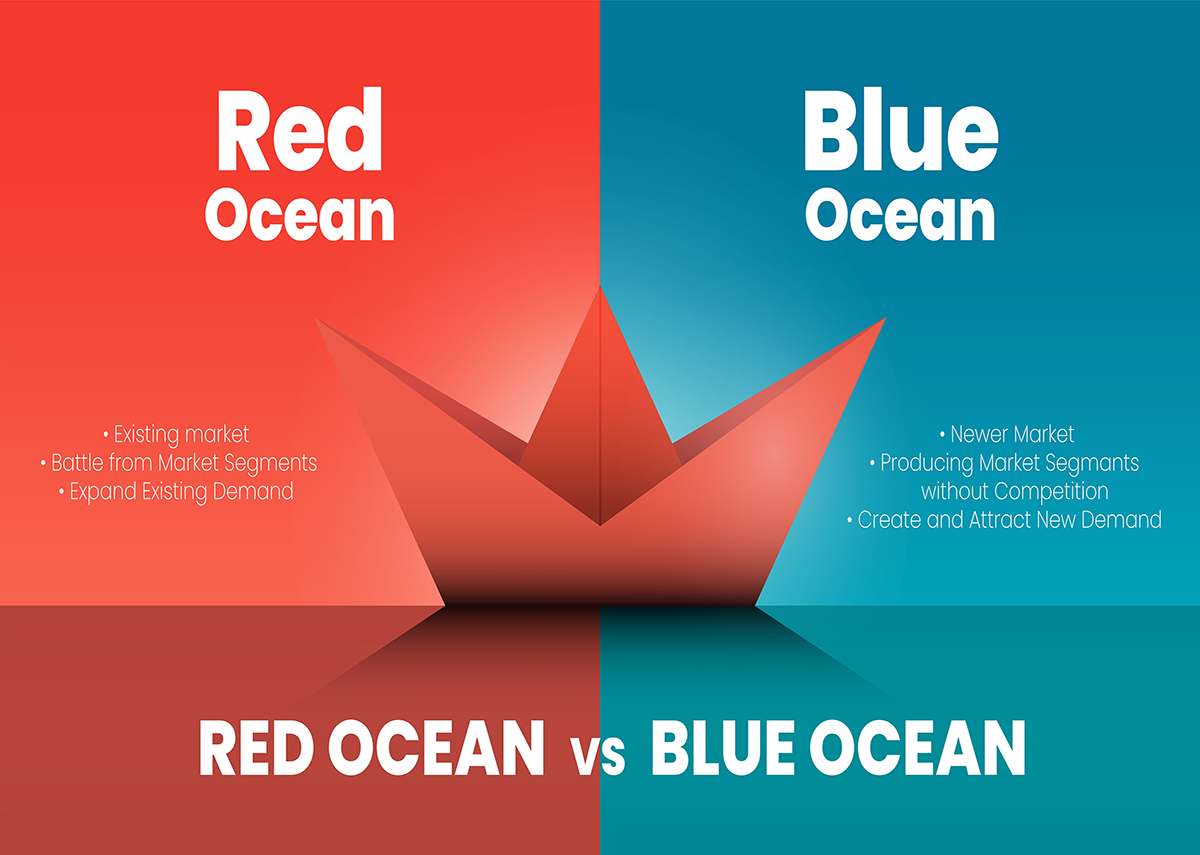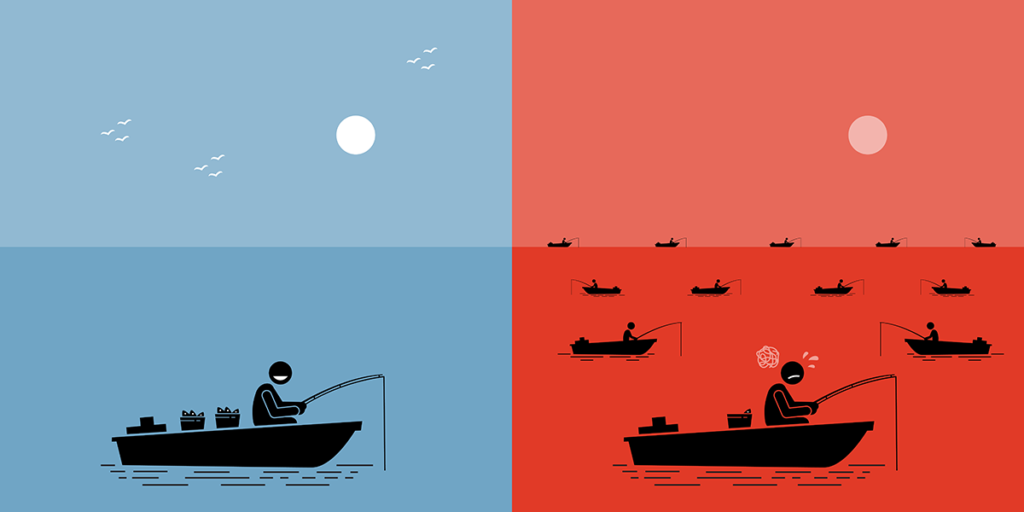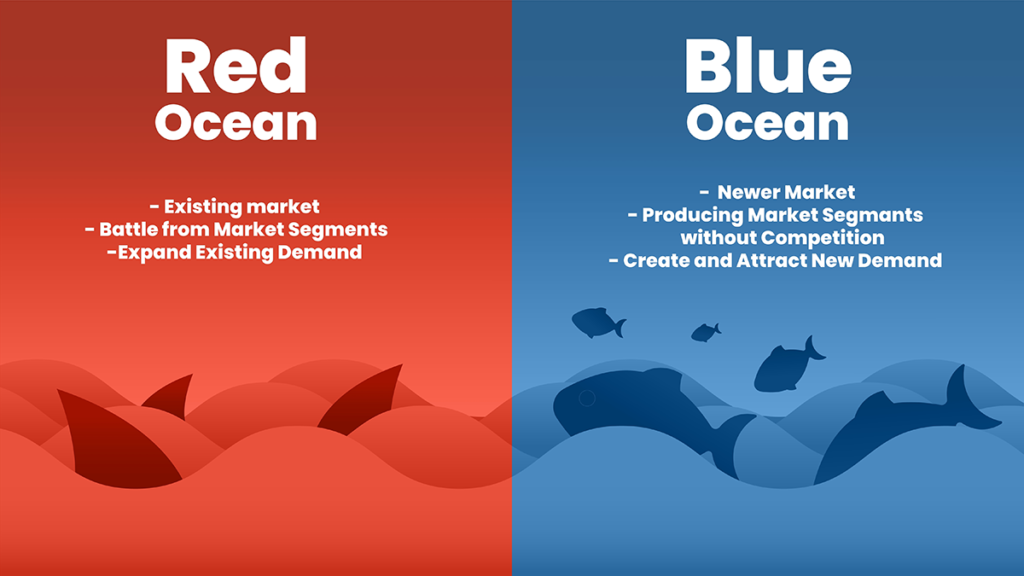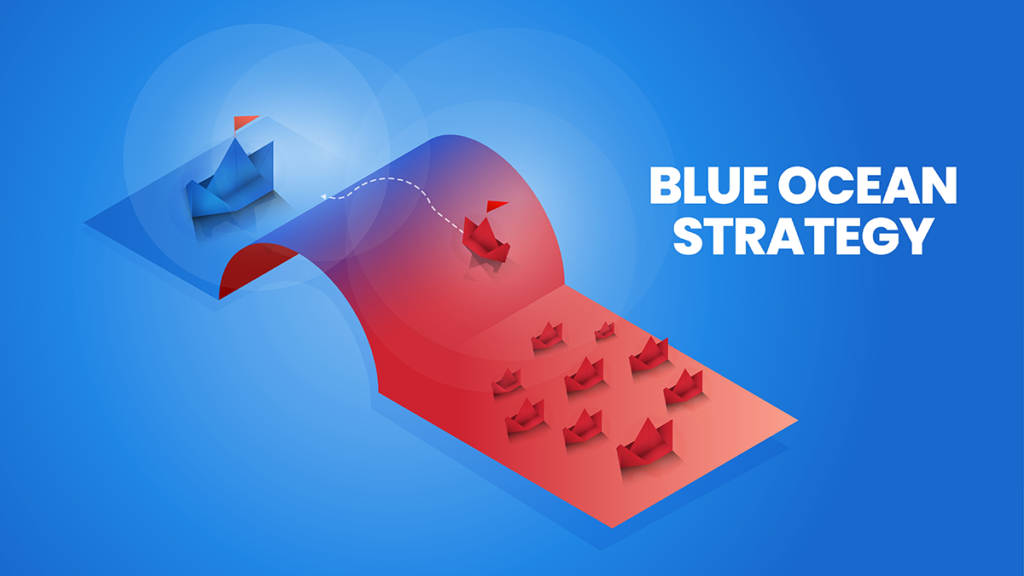Blue Ocean Strategy – blue and red ocean strategy
Language selection 📢
Published on: December 17, 2021 / update from: December 17, 2021 - Author: Konrad Wolfenstein
In connection with the Blue Ocean strategy, the term ocean describes a market or industry. “Blue oceans” are understood as pristine markets or industries that have little to no competition. The person who would dive into the blue ocean would thus discover undiscovered markets or industries. “Red oceans,” on the other hand, refer to saturated markets, characterized by fierce competition and crowded with competitors who all offer the same service or products.
The term “Red Ocean” is based on the image of bloody fights between predatory fish (the competitors), while the “Blue Ocean” is devoid of bloody fights.
The idea behind the Blue Ocean Strategy concept is that successful companies do not focus on competition, but instead look for their own innovative ways to create a Blue Ocean themselves. Innovations open up new markets and increase their attractiveness through the absence of some unattractive market characteristics that are less valued in previous competition. Successful innovations are rarely based on technological innovations, but rather on a new design of the overall offering. This often means a redefinition of the market or the consumer.
Blue Ocean methodology
The Blue Ocean Strategy is a method for developing long-term profitable business models in the area of strategic management: The basic idea is that only through the development of innovative and new markets that the broad masses of customers and non-customers Really differentiating and relevant benefits, “Blue Oceans” offer, lasting success can be achieved. This is to be achieved, among other things, by reducing competition, acquiring new customers and optimizing cost structures.
Value curves
First, a value curve is created for a market or industry in order to clarify which core elements characterize it from the perspective of customers and non-customers. Important features can, for example, be significant and highly competitive core attributes or investment drivers by competitors. The value curve of a company is visualized with the value curve of the current and potential competition.
Value curves within a strategic group (e.g. premium vs. low-cost providers) are usually interchangeable and represent an industry standard.
By changing the core elements that were previously defined, value curves can be permanently changed. There are four measures to redefine core elements:
Elimination
Which factors must be eliminated? Customers' benefit considerations can change dramatically, requiring some components of a product to be eliminated.
Reduction
What can be radically reduced? Too much differentiation drives up costs and can overwhelm customers.
Increase
What elements of the product need to be elevated above industry standards?
Creation
Which components of a product need to be reinvented? By changing the core elements of a value curve, new business models should be able to be developed.
implementation
Two aspects must be taken into account during implementation:
- Overcoming organizational hurdles (tipping point management)
- Integrate implementation into the strategy
Blue Ocean vs Red Ocean
Red Ocean Strategy
- Competition in the existing market
- Beat the competition
- Use existing demand
- Direct connection between benefits and costs
- Alignment of the entire system of corporate activities with the strategic decision for differentiation or low costs
Blue Ocean Strategy
- Creation of new markets
- Avoid the competition
- Tapping into new demand
- Eliminating the direct connection between benefits and costs
- Orientation of the entire system of corporate activities towards differentiation and low costs
Examples
Yellow Tail Wine
If not the oldest, then probably the most used example is a wine producer from Australia. The company had the stuck-in-the-middle problem and was therefore unable to establish itself properly in the market. By adapting the wine to an easy-drinking alcoholic beverage, reducing the quality at higher prices, the company was saved. The new target group was no longer wine drinkers who demand the quality and body of the wine, but rather beer drinkers who simply want to consume alcohol.
This means that a new market has been opened up and the company has pushed out the beer market.
Stuck in the Middle: The company is too small to compete with the market leaders and too large to exploit the niche of specialists.
Southwest Airlines
The oldest example is probably the story of the low-cost carrier Southwest Airlines, which looked at alternative industries and created new benefits for potential customers. Southwest Airlines positioned itself as a competitor to cars, not to other airlines, and adapted its strategy to the emerging needs:
- Reduced prices due to the elimination of additional services
- Improved check-in times and departure frequency
- Allows the customer to travel at high speed (airplane) at a low price (comparable to car)
A redefinition of the offer has taken place here. Customer is the everyday traveler, not just the business or leisure traveler.
The Body Shop
Another prominent example is the concept of The Body Shop, which created new functional and emotional benefits in the cosmetics industry. The usually glamorous appearance of cosmetics companies was ignored in the body shop concept. The Body Shop stood out with its functional appearance, reduced prices and unpretentious packaging. Increased emphasis has been placed on natural ingredients, healthy lifestyles and ethical concerns. As a result, The Body Shop reached a new customer base and was able to achieve very high cost savings (around 85% of costs through packaging and advertising).
Nintendo
A more recent example of a blue ocean strategy is the success of the Nintendo Wii game console, which was developed for a new video game audience. With a control concept using motion sensors, Nintendo is avoiding the competition for graphics and computing power from other consoles such as Microsoft's Xbox or Sony's PlayStation.
Nespresso
Another example is the introduction of the Nespresso coffee system by the food company Nestlé.
Cirque du Soleil
Cirque du Soleil has created a new market for itself in circus competition. The most obvious peculiarity is that, unlike in conventional circuses, no animals are shown. Rather, the focus here is on the artist and the combination of entertainment elements such as opera, ballet and rock music. The music is played exclusively live. The target group is no longer primarily families with children, but rather adults who are prepared to pay a correspondingly higher admission price for high-quality entertainment.
The book 'Blue Ocean Strategy'
Blue Ocean Strategy is a 2004 book by W. Chan Kim and Renée Mauborgne, both professors at INSEAD, a private business school founded in 1957 and headquartered in France. It is also the name of the marketing theory described in the book and is initially referred to as value innovation. Based on empirical studies over a period of 15 years, the analysis of more than 100 leading companies allowed us to find examples of companies that opened up new, previously unused sub-markets and thus made previous competition irrelevant.
They claim that these strategic steps create an increase in value for the company, its buyers and its employees, while they open up new demand and make the competition irrelevant. The book presents analysis frames and instruments that promote a company's ability to systematically create and conquer “blue oceans” - unexplored new market areas. An extended edition of the book was published in 2015, while a sequel, entitled Blue Ocean Shift 2017, was published.
The first part introduces the key concepts of the Blue Ocean strategy, including value innovation - the simultaneous pursuit of differentiation and low costs - as well as key analytical tools and frameworks such as the strategic planning overview and the four-action framework. The four-action framework helps eliminate the trade-off between differentiation and low costs within an organization. The four-action framework consists of the following elements:
Raise: This is about the question of which factors within an industry need to be raised in terms of product, price or service standards.
Eliminate: This is about which areas of a company or industry could be completely eliminated to reduce costs and create an entirely new market.
Reduce: This is about identifying which areas of a company's product or service are not essential but play an important role in your industry, e.g. B. the cost of producing a particular material for a product could be reduced. So it can be reduced without eliminating it completely.
Create: This causes the companies to be innovative in their products. By creating an entirely new product or service, a company can create its own market by differentiating itself from the competition.
In the second part, the four principles of Blue Ocean strategy formulation are described. These four formulation principles address how a company can create blue oceans by looking beyond the six conventional boundaries of competition (Six Paths Framework), reduce its planning risk by following the four steps of strategy visualization, create new demand by taps into the three tiers of non-customers and brings a commercially viable blue ocean idea to market by balancing the unparalleled value of an offering with strategic pricing and target costing, and overcoming adoption hurdles. Using numerous examples from various industries, the book shows how to break out of traditional competitive (structuralist) strategic thinking and increase demand and profits for the company and the industry using blue ocean (reconstructionist) strategic thinking. The four principles are:
- Creation of uncontested market space by reorganizing market boundaries
- Focus on the big picture
- Expand into new market spaces beyond existing demand and supply
- Find the right strategic order
The third and final part describes the two most important implementation principles of the Blue Ocean Strategy, including Tipping Point Leadership and fair processes. These execution principles are essential for leaders to overcome the four key organizational hurdles that can prevent even the best strategies from executing. The four main obstacles include the cognitive, resource, motivational and political hurdles that prevent those involved in strategy implementation from recognizing the need for a break with the status quo, finding the resources to implement the new strategy, the employees for win implementation of the new strategy and overcome the powerful vested interests that could block change.
In the book, the authors draw their readers' attention to the correlation of success stories in various industries and the formulation of strategies that offer a solid basis for unconventional success - a strategy called “Blue Ocean Strategy”. In contrast to the “Red Ocean Strategy”, the conventional business approach derived from the military organization to overcome the competition, the “Blue-Ocean strategy”, innovation tries to reconcile price and cost items. The book mocks the phenomenon of conventional choice between product/service differentiation and lower costs, but rather suggests that both differentiation and lower costs can be achieved at the same time.
The authors ask readers: “What is the best analysis unit for profitable growth? Company? Industry? " - A basic question without which every strategy for profitable growth does not make sense. The authors explain with original and practical ideas that neither the company nor the industry is the best analysis unit for profitable growth; Rather, it is the strategic move that creates the “blue ocean” and a persistently high performance. The book examines the experiences of companies from so different areas as watches, wine, cement, computers, automobiles, textiles, coffee machines, airlines, retailers and even the circus to answer this fundamental question and build on the argument that “value innovation ”The cornerstone of a Blue Ocean strategy is. Novement of value is necessarily the focus of the innovation to benefit, price and costs. This creates an undisputed market room and makes the competition irrelevant. The new chapters in the extended edition of the book deal with the question of how the three strategic propositions value, profit and humans can be developed and coordinated, how the Blue-Ocean strategy maintains and renewed at both business and company level can be and how the red-ocean traps can be avoided, the companies in the existing market remain anchored, even if they try to create new market dreams. [7] In the following section, the concept on which the book is based is explained in detail.
criticism
Many of the key concepts of the book have already been dealt with in Competing for the Future by Gary Hamel and CK Prahalad, which was published in 1996. The authors encouraged the managers to put new marketing rooms off, which they called a white space in order to "create and master new opportunities".
Xpert.Digital – Konrad Wolfenstein
Xpert.Digital is a hub for industry with a focus on digitalization, mechanical engineering, logistics/intralogistics and photovoltaics.
With our 360° business development solution, we support well-known companies from new business to after sales.
Market intelligence, smarketing, marketing automation, content development, PR, mail campaigns, personalized social media and lead nurturing are part of our digital tools.
You can find out more at: www.xpert.digital – www.xpert.solar – www.xpert.plus

































